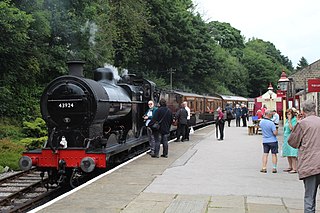
The Keighley & Worth Valley Railway (KWVR) is a 5-mile-long (8 km) heritage railway in the Worth Valley, West Yorkshire, England, which runs from Keighley to Oxenhope. It connects to the National Rail network at Keighley railway station.

The Great Central Railway in England was formed when the Manchester, Sheffield and Lincolnshire Railway changed its name in 1897, anticipating the opening in 1899 of its London Extension. On 1 January 1923, the company was grouped into the London and North Eastern Railway.

The Metropolitan Railway was a passenger and goods railway that served London from 1863 to 1933, its main line heading north-west from the capital's financial heart in the City to what were to become the Middlesex suburbs. Its first line connected the main-line railway termini at Paddington, Euston, and King's Cross to the City. The first section was built beneath the New Road using cut-and-cover between Paddington and King's Cross and in tunnel and cuttings beside Farringdon Road from King's Cross to near Smithfield, near the City. It opened to the public on 10 January 1863 with gas-lit wooden carriages hauled by steam locomotives, the world's first passenger-carrying designated underground railway.

The North Tyneside Steam Railway and Stephenson Steam Railway are visitor attractions in North Shields, North East England. The museum and railway workshops share a building on Middle Engine Lane adjacent to the Silverlink Retail Park. The railway is a standard gauge line, running south for 2 miles (3.2 km) from the museum to Percy Main. The railway is operated by the North Tyneside Steam Railway Association (NTSRA). The museum is managed by Tyne and Wear Archives and Museums on behalf of North Tyneside Council.

Ingrow is a suburb of Keighley, West Yorkshire, England that lies on the River Worth. The name Ingrow comes from Old Scandinavian which means 'corner of land in the meadow.' The suburb is located on the A629 road and is 0.93 miles (1.5 km) south west of Keighley town centre.

Ingrow (West) railway station is a single-platform station serving the suburb of Ingrow in Keighley, West Yorkshire, England. It is served by the preserved Keighley and Worth Valley Railway. The station is 1.25 miles (2 km) west of Keighley station and 2.25 miles (3.62 km) west of Haworth railway station.

Erwood railway station is a former station on the Mid Wales Railway in Erwood, between Brecon and Llanidloes, Powys, Wales.
The London and North Eastern Railway (LNER) inherited several styles of coaching stock from its constituents. Sir Nigel Gresley continued the styles that he had established pre-grouping at the Great Northern Railway (GNR) and for the East Coast Joint Stock.

The Scammell Scarab is a British 3-wheeled tractor unit produced by the truck manufacturer Scammell between 1948 and 1967. These vehicles are often known as "Snub-nose Trucks" or "Snub-nose Lorries" because of the round hood in front of the cab.
The Kent & East Sussex Railway has hosted a variety of heritage rolling stock since the line was closed by British Railways in 1961.
The Bluebell Railway is a heritage line West Sussex and East Sussex in England.

The London Underground opened in 1863 with gas-lit wooden carriages hauled by steam locomotives. The Metropolitan and District railways both used carriages exclusively until they electrified in the early 20th century. The District railway replaced all its carriages for electric multiple units, whereas the Metropolitan still used carriages on the outer suburban routes where an electric locomotive at the Baker Street end was exchanged for a steam locomotive en route.

Haydock Collieries were collieries situated in and around Haydock on the Lancashire Coalfield which is now in Merseyside, England. The company which operated the collieries was Richard Evans & Co Ltd.
The Rolling stock of the Keighley & Worth Valley Railway is used on the preserved Keighley & Worth Valley Railway, a 5-mile-long (8 km) branch line that served mills and villages in the Worth Valley and is now a heritage railway line in West Yorkshire, England. It runs from Keighley to Oxenhope. It connects to the national rail network line at Keighley railway station.

The Furness Railway Trust is a heritage railway preservation organisation many of whose properties were originally owned by the Furness Railway. It is now based at the Ribble Steam Railway at Preston, Lancashire, England following its relocation from the Lakeside and Haverthwaite Railway. New accommodation which is shared with the Ribble Steam Railway has been built and is used to house, restore and maintain the Trust's locomotives and other vehicles. The Trust often hires its locomotives and stock to other privately owned railways in the UK where they can be seen working.
The Swanage Railway is a railway branch line in Dorset, England, opened in 1885 and now operated as a heritage railway.

Beamish Museum contains much of transport interest, and the size of its site makes good internal transportation for visitors and staff purposes a necessity.












